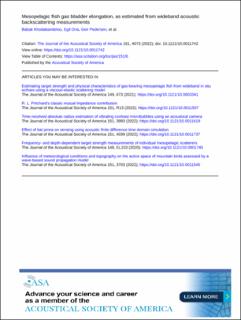| dc.contributor.author | Khodabandeloo, Babak | |
| dc.contributor.author | Ona, Egil | |
| dc.contributor.author | Pedersen, Geir | |
| dc.contributor.author | Korneliussen, Rolf | |
| dc.contributor.author | Melle, Webjørn Raunsgård | |
| dc.contributor.author | Klevjer, Thor Aleksander | |
| dc.date.accessioned | 2022-09-20T08:12:51Z | |
| dc.date.available | 2022-09-20T08:12:51Z | |
| dc.date.created | 2022-08-23T15:58:56Z | |
| dc.date.issued | 2022 | |
| dc.identifier.citation | Journal of the Acoustical Society of America. 2022, 151 (6), 4073-4085. | en_US |
| dc.identifier.issn | 0001-4966 | |
| dc.identifier.uri | https://hdl.handle.net/11250/3019034 | |
| dc.description.abstract | Backscattered acoustic energy from a target varies with frequency and carries information about its material properties, size, shape, and orientation. Gas-bearing organisms are strong reflectors of acoustic energy at the commonly used frequencies (∼18–450 kHz) in fishery surveys, but lack of knowledge of their acoustic properties creates large uncertainties in mesopelagic biomass estimates. Improved knowledge about the volume and elongation (i.e., longest to shortest dimension) of swimbladders of mesopelagic fishes has been identified as an important factor to reduce the overall uncertainties in acoustic survey estimates of mesopelagic biomass. In this paper, a finite element approach was used to model gas-filled objects, revealing the structure of the backscattering, also at frequencies well above the main resonance frequency. Similar scattering features were observed in measured broadband backscattering of several individual mesopelagic organisms. A method is suggested for estimating the elongation of a gas-bubble using these features. The method is applied to the in situ measured wideband (33–380 kHz) target strength (TS) of single mesopelagic gas-bearing organisms from two stations in the North Atlantic (NA) and Norwegian Sea (NS). For the selected targets, the method suggested that the average elongation of gas-bladder at the NA and NS stations are 1.49 ± 0.52 and 2.86 ± 0.50, respectively. | en_US |
| dc.language.iso | eng | en_US |
| dc.title | Mesopelagic fish gas bladder elongation, as estimated from wideband acoustic backscattering measurements | en_US |
| dc.title.alternative | Mesopelagic fish gas bladder elongation, as estimated from wideband acoustic backscattering measurements | en_US |
| dc.type | Peer reviewed | en_US |
| dc.type | Journal article | en_US |
| dc.description.version | publishedVersion | en_US |
| dc.source.pagenumber | 4073-4085 | en_US |
| dc.source.volume | 151 | en_US |
| dc.source.journal | Journal of the Acoustical Society of America | en_US |
| dc.source.issue | 6 | en_US |
| dc.identifier.doi | 10.1121/10.0011742 | |
| dc.identifier.cristin | 2045458 | |
| dc.relation.project | EC/H2020/817669 | en_US |
| dc.relation.project | Havforskningsinstituttet: 15093 | en_US |
| dc.relation.project | Norges forskningsråd: 280546 | en_US |
| cristin.ispublished | true | |
| cristin.fulltext | original | |
| cristin.qualitycode | 2 | |
